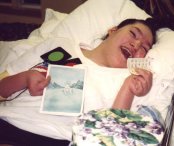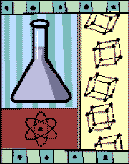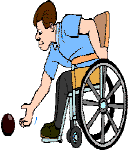The Cerebral Palsy Network
- Cerebral Palsy
- Hippo therapy
- Pediatric Stroke
- School Daze
- HBOT
- SDR
- Spasticity Management
- Cephalic Disorders
- CP & Aging
- BOTOX
Around CPN
Resource
Center
What is Hyperbaric Oxygen?
Hyperbaric oxygenation is the use of I00% oxygen at greater than atmospheric pressure. It
is the same oxygen that we breathe normally (which is 19-21% of
air). However under
pressure, oxygen, a gas, adheres to all of the laws of physics. When pressure is
increased, oxygen will be dissolved into any body fluid in direct proportion to the
pressure (Henry's Law). More oxygen, therefore, may be dissolved in the bone, the urine,
the lymph, especially the blood plasma and the cerebrospinal fluid (the fluid- that bathes
the entire central nervous system). Hyperbaric oxygenation is a method of delivering extra
oxygen into the body. It is not just the increased oxygen that is important, but that free
molecular oxygen is made immediately available for metabolic use by the mitochondria at
the tissue spaces in the body, where all life takes place.
Normally, in the body, oxygen is delivered to the, tissue spaces by way of the hemoglobin
in the blood. This requires energy to break off the oxygen molecule from the hemoglobin
and to pick up the carbon dioxide that is returned to the lungs to be exhaled. This is the
basic cycle of life. With Hyperbaric oxygenation, it is possible to greatly increase the
availability of oxygen. Hyperbaric oxygen has a positive effect on the nervous system in
that it reduces swelling, repairs the blood brain barrier and stabilizes the cell
membrane. It increases the ability of the phagocytes (white blood cells) to clean up
damaged areas and over a long term, it creates a whole new supply of blood vessels called
neo-angiogenesis. Also, it provides a mechanism whereby if there is hypoxic ischeinic
(severe lack of oxygen) damaged tissue in the brain that is not adequately supplied by way
of blood, Hyperbaric oxygen may be used immediately to deliver necessary oxygen to the
area for viability, damage control and healing.
Hyperbaric oxygen is a drug and is administered in a closed chamber and has a specific
dose which relates to the depth of pressure. This is referred to as the atmospheric
pressure absolute (ATA). Sea level is 1.00 ATA, with the partial pressure of 19-21
-percent of O'. The length of time of treatment, the pressure, the number of treatments
per 24 hours and the total number of treatments all represent the "dose".
There are two types of chambers. One is a monoplace chamber which is an acrylic tube and
compressed with 100% oxygen. There is no question as to the exact dosage (ATA) of oxygen.
The other type of chamber is a multi-station chamber that holds more than one patient. In
China, there are chambers that hold up to 36 patients and they actually perform open heart
surgery within the chamber. This type of chamber, however, is compressed with air and the
delivery of oxygen is either by way of mask or a hood. In the multi-station chamber
employing the mask delivery, the appropriate dose may not be accurate since the mask that
fits one person may not securely fit another and there can be leakage of the oxygen, thus
the exact pressure may not be achieved. Also, in some patients with severe head and facial
injuries, masks are impossible. The hood, however, is more accurate for Hyperbaric
oxygenation and fits over the head with a Velcro strap to seal it around the neck. The
monoplace chamber may be wheeled into an emergency room setting and be immediately
available for use. The multi-station, however, requires an attendant inside
the chamber with the patients and a technical engineer outside to regulate the pressures.
We are concerned that before this data is totally scientifically validated, a number of
centers may open up purely for financial purposes. Thus, it is imperative that before you
choose a center, you know:
1) That they have a "Medical Director" with an appropriate background in and knowledge of Hyperbaric medicine, as well as a consultant knowledgeable in developmental pediatrics
2) the protocol for treating the neuroloizically injured child,
3) Whether the chamber will accommodate a parent to go in with the child,
4) The charge per treatment. The charges may vary from $150-$1,000. per hour.
5) Membership in an association such as The American College of Hyperbaric Medicine,
the Undersea and Hyperbaric Medical Society or the newly founded Association of
Free-standing Hyperbaric Centers.
Certain centers may insist upon controlled studies. For the scientific evaluation of this
procedure in the older child, cross-over double blind studies may be needed. This means
that a group of children will be randomly assigned, one to a chamber breathing only air
(sham or placebo treatment) and another to a chamber with oxygen. Double blind means that
neither the doctors nor the patients will know which patients are actually receiving the
oxygen treatment until the study and all evaluations are complete. After a completion of
approximately 40 treatments, the code will be broken. If there is a difference between the
two groups, (i.e., the results are more positive with the
oxygen), those who were given
the sham treatment will be crossed over and given the oxygen treatment.
This may be satisfactory for a child several years old, but the ideal situation would be
to take the brain injured newborn from the delivery room to the Hyperbaric chamber to
prevent/repair the damage immediately. With newer diagnostic techniques such as
transcranial doppler, functional MRI and SPECT scanning, brain injuries can sometimes be
detected at birth. It is at this time that the patient should be considered for treatment
as is done in Mexico City and has been for many years in Russia and a British trial
published in 1964 in The Lancet.
Under such circumstances that the questions of the ethics of the double-blind study exist:
Should only half the babies be given the actual treatment if it may safely benefit all of
them? This will be one of the topics for discussion in this program.
The safety record for Hyperbaric oxygen treatment is excellent. In the United Kingdom,
there have been 1.3 million hours of outpatient Hyperbaric oxygen administered without
incident. Certain outpatient centers insist upon myringotomy, i.e., tubes put into the
ears of the children to equalize the pressure. We do not feel that this is necessary if
the compression and decompression are appropriately done. In our experience, 1 out of
several hundred children may require this. Ear inspection prior to and during the course
of treatment is mandatory.
Side effects are primarily (> 5% of patients) sinus squeeze or ear pain - like taking
off and landing in an airplane. Long term treatments in the elderly may have an
acceleration effect on cataract formation. In children, a transient change may rarely
occur in the lens to make them more nearsighted. This is rapidly fleeting and there is no
permanent sequelae known.
N.B.: Seizure disorder is not a contraindication to Hyperbaric
oxygenation. In China, seizure disorders are treated with Hyperbaric oxygen. We have
treated many cases, and in certain patients, reduction or discontinuance of ant-seizure
medication was accomplished. Pressures, however, must be begun at a low pressure 1.25 ATA
for thirty minutes and gradually worked up to 1.5 ATA for one hour twice a day.
It is hoped that as a result of this conference that:
1) the proper subset of patients and the timing in which this treatment is most advantageous will be ascertained,
2) an appropriate protocol will be determined,
3) a database will be established,
4) patients
will have an information source and be able to access the website hopefully for approved
centers, i.e., that is those being members of an association or being guided by a
responsible M.D., 5) the role of various other modalities in conjunction with
Hyperbaric oxygen in the future will be further evaluated, such as biofeedback, amino acids,
craniosacral therapy, herbal medications, physical, speech and occupational therapies.
Although the positive evidence is compelling and highly suggestive, until this is
scientifically validated and appropriately documented, please do not rush into this type
of therapy.
It is hoped that someday, should all of this data be appropriately evaluated
scientifically, that no brain injured child will ever be denied Hyperbaric oxygenation
because of financial or social reasons.
A special thankyou to the countless Drs and children whom have made this research possible. All information contained within these pages are the sole property of the Dr.s and experts that have spent the countless hours researching for OUR CHILDREN. Please read each page of content and please contact your local congressmen and appropriate government officials today. Thankyou.
This site designed & maintained by Mystic Dawn Web Creations. The Cerebral Palsy Networkę1997/2003. All graphics are the exclusive property of CPN, unless otherwise indicated. Contact CPN at Cerebral Palsy Network for further information.
Last updated 03/24/03

Amanda the reason CPN was
started
CPN
Reunion 2003

CP
Research
What's happening Today with
Cerebral Palsy

Special
Olympics
What's happening with
Special Olympics in 2003

CP
& Education
What's happening with
Special Need and Education in 2003